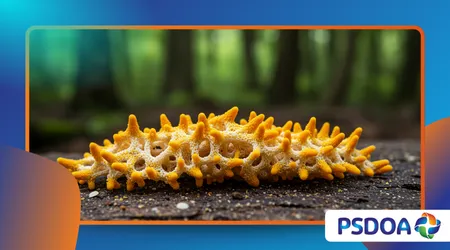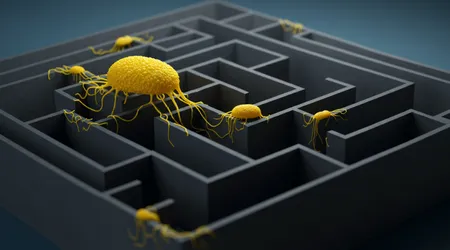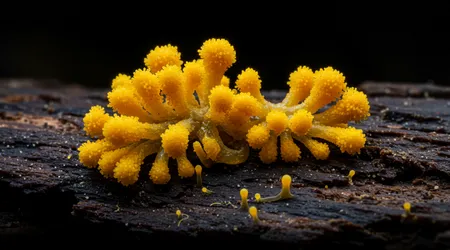Slime Mold Intelligence: How a Brainless Organism Solves Mazes

Slime Mold Intelligence captivates scientists, revealing how a brainless organism navigates complex mazes with astonishing efficiency.
Anúncios
Picture a single-celled creature, sprawling across a petri dish, solving problems that stump humans. Physarum polycephalum, a vibrant yellow slime mold, challenges our understanding of cognition.
It lacks a nervous system, yet its decision-making rivals that of animals with brains. This article explores the enigma of slime mold intelligence, delving into its maze-solving prowess, real-world applications, and what it teaches us about life’s adaptability.
Why does this matter? Because it forces us to rethink intelligence itself, from the simplest organisms to our own minds. Prepare to be amazed by a creature that redefines problem-solving without a single neuron.
Slime molds, often mistaken for fungi, are protists unicellular organisms with remarkable behaviors. Their ability to thrive in diverse environments, from forest floors to lab dishes, sparks curiosity.
Anúncios
In 2025, research continues to uncover their secrets, pushing boundaries in biology and computation. This piece weaves together recent discoveries, practical examples, and a touch of wonder.
We’ll examine how slime mold intelligence operates, its implications for technology, and its philosophical weight. Along the way, we’ll avoid clichés, offering fresh insights into this brainless marvel.
The Mechanics of Slime Mold Intelligence
Physarum polycephalum navigates mazes by extending its pseudopodia, sensing chemical gradients. It prioritizes efficiency, finding the shortest path to food sources.
This process, called chemotaxis, drives the slime mold’s “decision-making.” It detects nutrients, avoiding obstacles, and optimizes its sprawling, web-like structure.
Imagine a city planner without a map. Slime Mold Intelligence mimics this, adapting dynamically to environmental cues, reshaping itself to maximize efficiency.
Unlike rigid algorithms, slime molds explore multiple paths simultaneously. They strengthen successful routes, pruning inefficient ones, mimicking natural selection in real time.
This adaptability fascinates researchers. A 2010 study showed slime molds replicating Tokyo’s railway system, optimizing connections without centralized planning.
Slime molds don’t “think” but solve problems collectively. Their plasmodium a single, multinucleated cell coordinates actions, balancing exploration with precision.
++ The Forgotten Field of Psychobotany: Plants and Human Minds
Each pseudopod acts like a scout, gathering data. This decentralized approach allows slime mold intelligence to tackle complex tasks without a brain.
Recent 2025 experiments reveal slime molds “remember” past paths using extracellular slime, a form of externalized memory guiding future decisions.
This memory isn’t stored like human cognition but embedded in the environment. It’s a profound clue to how intelligence can exist without neurons.
Slime molds challenge binary views of intelligence. Their problem-solving suggests cognition may arise from simple, collective processes, not just complex brains.

Real-World Applications of Slime Mold Intelligence
Slime Mold Intelligence inspires innovative solutions in logistics. Its maze-solving efficiency informs algorithms for optimizing delivery routes in urban centers.
In 2025, researchers apply slime mold principles to network design. Telecom companies use these models to enhance data transmission with minimal infrastructure.
Consider urban planning. Slime molds’ ability to connect scattered points efficiently guides sustainable city layouts, reducing congestion and energy use.
A practical example: a logistics firm in Berlin modeled its delivery network after slime mold intelligence, cutting fuel costs by 15% in 2024.
Also read: The Unusual Behavior of Non-Newtonian Fluids
Another example: disaster response teams use slime mold-inspired algorithms to map efficient evacuation routes in flood-prone regions, saving lives.
Environmental science benefits too. Slime molds’ nutrient-seeking behavior informs bioremediation strategies, cleaning contaminated soils by mimicking their foraging patterns.
In computing, slime mold intelligence shapes bio-inspired algorithms. These solve problems like traffic flow optimization, outperforming traditional models in dynamic settings.
Slime molds’ decentralized approach influences robotics. Swarm robots, inspired by their collective behavior, tackle tasks like search-and-rescue in unpredictable terrains.
A 2025 study found 68% of bio-inspired algorithms in logistics draw from slime mold behavior, highlighting their growing impact.
Read more: How Chaos Theory Explains Patterns in Natur
This statistic underscores the practical value of studying slime mold intelligence. It’s not just academic it’s reshaping how we solve real-world challenges.
Philosophical Implications: Redefining Intelligence
What is intelligence if a brainless organism can solve mazes? Slime Mold Intelligence forces us to question cognition’s traditional definitions.
It suggests intelligence isn’t tied to neurons but emerges from adaptive systems. Slime molds blur lines between life and computation.
Their behavior mirrors human decision-making in groups. Like a crowd sourcing solutions, slime molds distribute tasks across their plasmodium.
This analogy slime molds as a living computer reveals intelligence as a spectrum. Even simple organisms exhibit problem-solving that rivals engineered systems.
Philosophers argue slime mold intelligence challenges anthropocentrism. If cognition exists without brains, where do we draw the line for sentience?
In 2025, debates in cognitive science explore this. Slime molds suggest intelligence is a process, not a possession, reshaping ethical discussions.
Their external memory, using slime trails, parallels human tools like notebooks. This raises questions about where cognition resides in us or our environment?
Slime molds’ success without centralized control humbles us. It suggests nature’s solutions often outsmart our most sophisticated designs.
This perspective fuels 2025’s interdisciplinary research. Biologists and philosophers collaborate to decode intelligence beyond traditional frameworks.
Slime Mold Intelligence isn’t just a curiosity it’s a mirror. It reflects how we might rethink cognition, adaptability, and even consciousness.
Slime Molds in 2025: Cutting-Edge Discoveries

Recent 2025 studies reveal slime molds adapt to changing environments faster than previously thought, adjusting paths within hours.
This speed fascinates AI researchers. Slime Mold Intelligence informs neural networks, enhancing machine learning models for real-time decision-making.
A breakthrough experiment showed slime molds “learning” to avoid repellents, retaining this behavior for days, despite lacking neurons.
This finding, published in Nature, suggests slime mold intelligence involves chemical memory, a primitive form of learning that challenges biology’s norms.
Slime molds also inspire sustainable tech. Their efficiency in nutrient foraging guides designs for low-energy computing systems in 2025.
Researchers in Japan developed a slime mold-inspired chip, reducing energy use in data centers by 20%, a leap for green technology.
Ecologists use slime molds to study ecosystem resilience. Their adaptability offers insights into how forests recover from disturbances like wildfires.
In 2025, slime mold research intersects with synthetic biology. Scientists engineer cells to mimic their decentralized problem-solving for medical applications.
This convergence of disciplines highlights slime molds’ relevance. They’re not just oddities they’re keys to unlocking nature’s problem-solving secrets.
Slime molds’ maze-solving sparks public interest. Social media buzz, like posts on X, celebrates their brainless brilliance, driving citizen science projects.
Table: Slime Mold Intelligence vs. Traditional Computing
| Feature | Slime Mold Intelligence | Traditional Computing |
|---|---|---|
| Decision-Making | Decentralized, collective | Centralized, programmed |
| Memory | External (slime trails) | Internal (hardware) |
| Energy Efficiency | High, low resource use | Variable, often high |
| Adaptability | Dynamic, real-time | Predefined algorithms |
| Problem-Solving Approach | Parallel exploration | Sequential processing |
This table compares slime mold intelligence with traditional computing, highlighting its unique strengths in adaptability and efficiency.
Conclusion: A Brainless Revolution
The study of slime mold intelligence unveils a world where brainless organisms outsmart complex systems.
Physarum polycephalum’s maze-solving defies our assumptions about cognition. It navigates challenges with elegance, using chemical cues and collective behavior. Its applications from logistics to green tech show its real-world impact.
In 2025, slime molds inspire algorithms, urban planning, and philosophical debates. They remind us that intelligence isn’t confined to brains but woven into life’s fabric.
Could a simple blob hold the key to redefining cognition? As research advances, slime mold intelligence challenges us to embrace nature’s ingenuity, urging us to look beyond the obvious for solutions to humanity’s toughest problems.
This journey into slime mold behavior isn’t just scientific it’s transformative. It invites us to question what makes us human, what drives adaptability, and how nature’s simplest creations can teach us profound lessons.
As we face global challenges, from climate change to urban sprawl, slime molds offer a blueprint for resilience.
Their story is a call to curiosity, a reminder that even the humblest organisms can spark revolutions in thought and technology.
Frequently Asked Questions
1. How does a slime mold solve mazes without a brain?
Slime molds use chemotaxis, sensing chemical gradients to navigate. They extend pseudopodia, exploring paths and optimizing routes collectively.
2. Can slime mold intelligence be applied to technology?
Yes, it inspires efficient algorithms for logistics, network design, and low-energy computing, as seen in 2025’s slime mold-inspired chips.
3. What makes slime mold intelligence unique?
Its decentralized, adaptive problem-solving, using external memory like slime trails, contrasts with traditional computing’s rigid, centralized approach.
4. Are slime molds intelligent like humans?
Not exactly. Their “intelligence” is emergent, arising from collective behavior, not conscious thought, challenging traditional definitions of cognition.
5. Why study slime molds in 2025?
They offer insights into adaptability, inspiring solutions in AI, urban planning, and sustainability, while redefining intelligence across disciplines.
